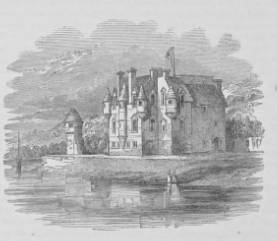
Newark Castle on the Clyde drawn by Robert William Billings (1814-1874) and engraved by J. H.Le Keux. Source: Edinburgh (1852). [Click on image to enlarge it.]
Commentary by the Artist
The many thousands of summer travellers along tlie Firth of Clyde, whether by steam-boat or railway, can scarcely forget a massive brown edifice, decayed but not ruined, rising with its square tower and rich cluster of cones and chimneys, in singular contrast to the spruce newness or Greenock, Port-Glasgow, and the villas of the Glasgow merchants studded here and there along the sloping banks of the majestic estuary. This old building is close to the edge of the water, and is almost touched by the Glasgow and Greenock Railway. It is of two ages of architecture. First, we have the old characteristic square tower of the pristine Scottish mansion. But in the present instance it has evidently been altered at the time when the rest of the building was raised, for the original loopholes appear to have given way to one or two of the large moulded and canopied win- dow-cases of the days of Inigo Jones. Instead of terminating in the usual manner, in a battlement, with a narrow crow-stepped roof rising within it, a wall has been raised flush with the edge of the parapet, pierced with ornamented windows of the class already alluded to. The peculiarities of this tower bear a very close resemblance to those of Preston in East Lothian. The more modern portions of the building are a fine development of the French style of architecture, so prevalent in Scotland in the seventeenth century ; and the windows are larger and more richly adorned than they are generally found to be in the country mansions of the period, reminding one of Wyntoun House, Heriot's Hospital, and some portions of Linlithgow Palace. The long steep roofs, the crow-steps, and the tall chimneys, harmonise with the many turrets, in presenting, especially towards the river, the preponderance of perpendicular lines which gives these old French mansions their peculiar character.


The barony of Newark was one of the ancient possessions of the Denziltons, or Dennistouns, then a widely-spread and prosperous family in Renfrewshire. About the commencement of the fifteenth century, an heiress of that name transferred it by marriage to the family of Maxwell, then rising to eminence and acquiring many estates in the west beyond the boundaries of their original territories In Galloway (Historical and Descriptive Notices of Renfrewshire, 140). We hear of the laird of Newark in the wild feuds of the Maxwells, Cunninghames, Montgomerles, and Johnstones. Montgomery of Skelmorlie having been a participator in the slaughter of Maxwell of Stanley, Patric Maxwell of Newark retaliated by killing the author of the deed and his son, both in one day. This tragedy occurred in 1583. In that age of violence the law sometimes made up for its inablHty to strike the criminal in the pride and power of successful violence, by remembering his misdeeds when many years had passed over them, and the times became propitious for punishment. Thus, in 1611, Maxwell was brought to trial, "dilated of art and part of the slaughter of umquliile Kobert Montgomery of Skelmourlle, and William Montgomerie, appearand of Skelmourlle."(Pitcairn's Criminal Trials, III, 122.). warrant of the privy council, the charge was deserted, on the accused finding security to appear before that body, and the case does not make its appearance again in the criminal records. In 1593, he joined his clan in a bloody contest with the Johnstones at Lockerby. This battle, conducted on a scale resembhng that of a civil war, arose out of the ordinary source of borderfeuds — a foray by tbe Jobnstoncs, in which nine of their men were caught and hanged. To avenge this fatal termination of their predatory efforts, they held a general gathering, and ravaged Nithesdale. The opposite party attempted to retaliate, but were defeated ; and as both proceeded from outrage to outrage, old recollections of rankling revenge revived, and fresh bodies joined each opposing banner. At Lochmaben, the Maxwells, finding their opponents too numerous, had taken refuge in the parish church. The Johnstonea, who had with them the Scotts of Buccleugh, and other families of the border, suiTOunded the church, set it on fire, and compelled the refugees to die quietly in the blazing ruins, or seek death from their adversaries' weapons without. It was under the impulse created by this act of barbarous vengeance that the adherents of tlie Maxwells gathered to the number of two thousand men, and fought the battle of Lockerby, where they were again doomed to be defeated. Patrick, the laird of Newark, who partook in these acts of violence, is supposed to have afterwards built a considerable portion of the castle, as his initials, P. M., appear over the windows.
This castle ceased to belong to the Maxwells at tbe commencement of the eighteenth century; and, after having had various owners, it became lately the property of Lady Shaw Stewart.
R. W. B.
[These images may be used without permission for any scholarly or educational purpose without prior permission as long as you credit the Hathitrust Digital Archive and the University of California library and link to the the Victorian Web in a web document or cite it in a print one — George P. Landow ]
Bibliography
The Baronial and Ecclesiastical Antiquities of Scotland illustrated by Robert William Billings, architect, in four volumes.. Edinburgh and London: William Blackwood and Son, 1852. Hathitrust Digital Archive version of a copy in the University of California Library. Web. 10 October 2018.
Last modified 13 October 2018